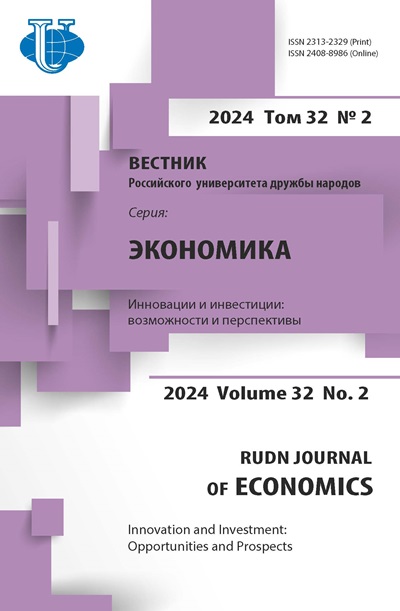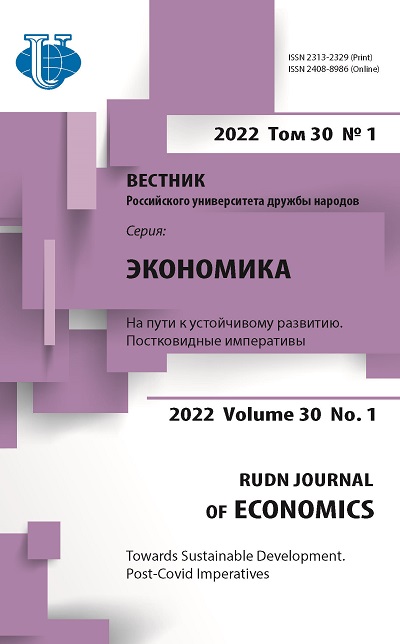Государственная политика Замбии по привлечению прямых иностранных инвестиций и ее эффективность
- Авторы: Андронова И.В.1, Хаабазока Л.2, Касонде А.М.1
-
Учреждения:
- Российский университет дружбы народов
- Университет Замбии
- Выпуск: Том 30, № 1 (2022): НА ПУТИ К УСТОЙЧИВОМУ РАЗВИТИЮ. ПОСТКОВИДНЫЕ ИМПЕРАТИВЫ
- Страницы: 33-44
- Раздел: МИРОВОЙ РЫНОК КАПИТАЛА
- URL: https://journals.rudn.ru/economics/article/view/30655
- DOI: https://doi.org/10.22363/2313-2329-2022-30-1-33-44
Цитировать
Полный текст
Аннотация
Инвестиционная политика всегда играла одну из важнейших ролей в развитии национальной экономики. Прямое иностранное инвестирование взаимосвязано с деятельностью транснациональных компаний и возможностями, которые может получить принимающая страна. В статье раскрывается инвестиционная политика Замбии и роль, которую играет в ней государственный сектор. Выявленные конкурентные преимущества доказывают, что Замбия имеет значительный инвестиционный потенциал, хотя у страны нет прямого выхода к морю. Значительные запасы минерального сырья подтверждают энергетическую и ресурсную обеспеченность экономики, что является сферой приложения инвестиций со стороны как национальных, так и иностранных компаний. Уделяется внимание ряду важных проблем социально-экономического значения, которые осложняют эффективное и полноценное функционирование экономики. Авторами было установлено, что в отечественной и зарубежной литературе исследований, посвященных инвестиционному потенциалу Замбии, недостаточно. Изучение входящей инвестиционной активности показало, что свободные экономические зоны являются наиболее эффективным инструментом привлечения ПИИ, при этом добывающий сектор остается самым привлекательным в данной сфере. Сравнительный анализ недостатков и преимуществ экономики Замбии, проведенный авторами, доказывает, что государство обладает необходимыми элементами инвестиционной привлекательности. При этом подчеркивается, что приход инвестиций в страну должен отвечать и социально-экономическим интересам государства.
Об авторах
Инна Витальевна Андронова
Российский университет дружбы народов
Email: aiv1207@mail.ru
ORCID iD: 0000-0002-7861-5414
доктор экономических наук, профессор, заведующая кафедрой международных экономических отношений, экономический факультет
Российская Федерация, 117198, Москва, ул. Миклухо-Маклая, д. 6Любинда Хаабазока
Университет Замбии
Автор, ответственный за переписку.
Email: aiv1207@mail.ru
ORCID iD: 0000-0003-4055-2531
доктор философии, директор Высшей школы бизнеса
Замбия, 32379, Лусака, Кампус Грейт-Ист-РоудАарон Мвева Касонде
Российский университет дружбы народов
Email: 1032175656@pfur.ru
студент программы «Международные экономические отношения и внешнеэкономическая деятельность» экономического факультета Российская Федерация, 117198, Москва, ул. Миклухо-Маклая, д. 6
Список литературы
- Anglin, D.G., & Shaw, T.M. (2021). The Foreign Policy System of Zambia. Zambia’s Foreign Policy (p. 39).
- Bank of Zambia (2018). Foreign private investment and investor perceptions in Zambia (pp. 5-8). Retrieved August 15, 2021, from https://www.boz.zm/ForeignPrivateandInvestorPerceptionReport2018.pdf
- Denisova, T.S. (Ed.). (2013). Zambia: Reference and monographic publication. Monograph (p. 334). Moscow: Institute of Africa of the Russian Academy of Sciences.
- Dunhan, K.M. (1989). Vegetation-environment relations of a Middle Zambezi floodplain. Plant Ecology, 82(1), 13-24.
- Fanshawe, D.B. (1971). The vegetation of Zambia. Retrieved August 15, 2021, from https://www.biblio.com
- Fundanga, C.M., & Mwaba, A. Privatization of Public Enterprises in Zambia: An Evaluation of the Policies, Procedures and Experiences. African development bank economic research papers № 35. Retrieved August 15, 2021, from https://www.afdb.org/fileadmin/uploads/afdb/Documents/Publications/00157604-FR-ERP-35.PDF
- Knoema Data Platform (2021). Zambia Net FDI inflows, 1960-2021. Retrieved August 15, 2021, from https://knoema.com/atlas/Zambia/topics/Economy/Balance-of-Payments-Capital-and-financial-account/Net-FDI-inflows
- Lusaka South Multi-facility Zone Limited (2021). Annual Report 2020. Retrieved August 15, 2021, from https://lsmfez.co.zm/wp-content/uploads/2021/06/LS-MFEZ-Annual-Report-2020-2.pdf
- Pilossof, R., & Cohen, A. (2021). Zambia. Labour and Economic Change in Southern Africa c. 1900-2000 (p. 236).
- Prokopenko, L.Ya. (2018). The Principle ‘One Zambia, One Nation’: Fifty Years Later. Social Evolution & History, 17(1), 60-75.
- Prokopenko, L.Ya. (2019). Political stability and characteristics of national building in Zambia. Asia and Africa today, (9), 39-45. http://dx.doi.org/10.31857/S032150750006272-1
- Sanches, E. (2020). Zambia. Africa Yearbook Politics, Economy and Society South of the Sahara (p. 554).
- Santandertrade (2021). Foreign investment in Zambia. Retrieved August 15, 2021, from https://santandertrade.com/en/portal/establish-overseas/zambia/investing
- The World Bank (2020). Foreign direct investment, net inflows. Retrieved August 18, 2021, from https://data.worldbank.org/indicator/BX.KLT.DINV.CD.WD
- U4 Anti-corruption resource center (2020). Zambia overview of corruption and anti-corruption. Retrieved August 15, 2021, from https://www.u4.no/publications/zambia-overview-of-corruption-and-anti-corruption-2020.pdf
- World Bank Group (2020). Economy profile of Zambia. Doing business (p. 67). Retrieved August 15, 2021, from https://www.doingbusiness.org/content/dam/doingBusiness/country/z/zambia/ZMB.pdf
- World Bank Group (2020). Poverty and equity brief. Zambia (p. 2). Retrieved August 18, 2021, from https://databank.worldbank.org/data/download/poverty/987B9C90-CB9F-4D93-AE8C-750588BF00QA/SM2021/Global_POVEQ_ZMB.pdf
- Zambia Development Agency (2006). The Zambia Development Agency Bill. Retrieved August 15, 2021, from https://www.zda.org.zm/wp-content/uploads/2020/12/ZDA-Act-2006-1.pdf
- Zambia Development Agency (2020). Annual report 2019. Retrieved August 15, 2021, from http://ayokos.com/vs/zdanew/wp-content/uploads/2020/09/ZDA-2019-ANNUAL-REPORT.pdf
- Zambia-China Economic & Trade Cooperation Zone (ZCCZ) Ltd. Investment promotion. Retrieved August 15, 2021, from http://zccz.cnmc.com.cn/outlineentem.jsp?outlinetype=2&column_no=071302















